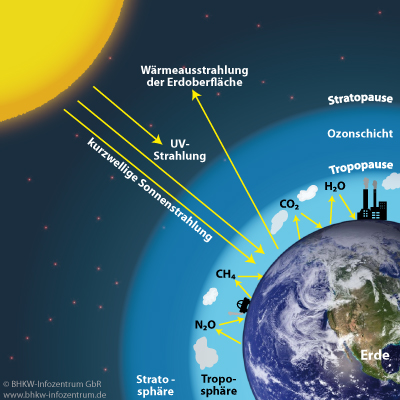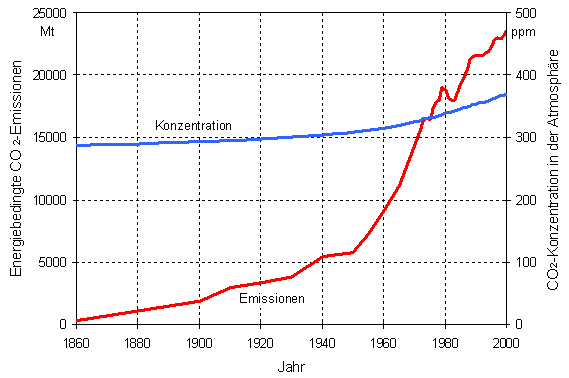Focus of attention in recent years regarding environmental protection in addition to the levels of ozone in the atmosphere and the phase-out of nuclear power, has been the human-induced greenhouse effect and its impact on our climate.
The greenhouse effect can be explained as follows: The sun’s rays, which lie mainly in the short-wavelength, visible wavelengths pass, the Earth’s atmosphere without significant absorption. The surface of the Earth heated by solar radiation emits heat radiation that have a longer wavelength. These are partially absorbed in the atmosphere of trace gases and reflected back to the surface. The added amount of energy to the surface must be consistent with the amount of energy dissipated in unison. To obtain this energy balance, the global surface temperature is higher than in case of the absence of greenhouse gases. This natural greenhouse effect means that instead of a global mean temperature of -18 ° C instead a mean temperature of 15 ° C exists on earth. This effect is triggered mainly by the atmospheric components of water vapor, carbon dioxide (CO2), methane (CH4), nitrous oxide (thick nitrogen, N2O) and ozone (O3) in their natural concentration.

Greenhouse gas effect
Due to the sharp increase in anthropogenic greenhouse gas emissions and the resulting existing higher concentration of these gases in the atmosphere (see Table), an additional human-induced (anthropogenic) greenhouse effect.
|
Kohlendioxyd CO2 |
Methan CH4 |
Lachgas N2O |
Fluorkohlenwasserstoffe CHF3 u.a. |
perfluorierte Fluorkohlenwasserstoffe CF4 u.a. |
Schwefelhexafluorid SF6 |
|
|
Verweildauer in der Atmosphäre, in Jahren |
50-200 |
9 – 15 |
120 |
264 |
50 000 |
3 200 |
|
Treibhauswirksamkeit (Global Warming Potential GWP) |
1 |
21 |
310 |
11 700 |
6 500 |
23 900 |
|
Konzentration in der Atmosphäre 1994 |
358 ppm |
1720 ppb |
312 ppb |
k.A. |
72 ppt |
3-4 ppt |
|
Zunahme der Konzentration seit Beginn der Industrialisierung |
28 % |
146 % |
13 % |
k.A. |
von 0 ppt auf 72 ppt |
von 0 ppt auf 3-4 ppt |
ppm: parts per Million = 1 Teil pro 1 Million Teile
ppb: parts per billion = 1 Teil pro 1 Milliarde Teile
ppt: parts per trillion = 1 Teil pro 1 Billion Teile
Many scientists therefore consider it possible, that an increase in the annual average temperature of 3 ° C will be reached within the next 100 years. The resulting climate changes could take dramatic consequences.

Carbon dioxide (CO2) is in relation to the anthropogenic greenhouse effect is the most important trace gas. About half of the anthropogenic greenhouse effect is attributed to it. Approximately 98% of CO2 emissions in the Federal Republic of Germany are produced by energetic activities. In the Kyoto Protocol, the Federal Republic of Germany has committed itself to reduce emissions of greenhouse gases by the year 2010 by 21% compared to emissions in 1990. One way of reducing CO2 represents the use of the coupled heat and power supply through cogeneration (CHP).
Already in the report „Future of the Earth“ (1995) of the Study Commission „Protection of the Atmosphere“ the importance of energy conservation for climate change is highlighted. In public debate, the combined heat and power plays only a minor role, although it represents a CO2 reduction strategy, which – in contrast to the renewable energy sources – already short and medium term can reduce the emissions of greenhouse gases significantly.
Another issue that has risen since the report of the „Club of Rome“ moved into the public attention, represents the finite nature of fossil resources. Although due to a search for new mineral resources and the improvement of mining technology, the exploitable energy resources have increased in recent years, conventional oil and gas reserves in this area are only sufficient for a few more decades. This particularly applies when you consider the worldwide growth and increase in energy consumption. Only our rich coal reserves will probably last for several centuries. With greater use of this energy source, however, would lead to higher specific CO2 emissions of coal and therefore an intensification of the greenhouse effect.









